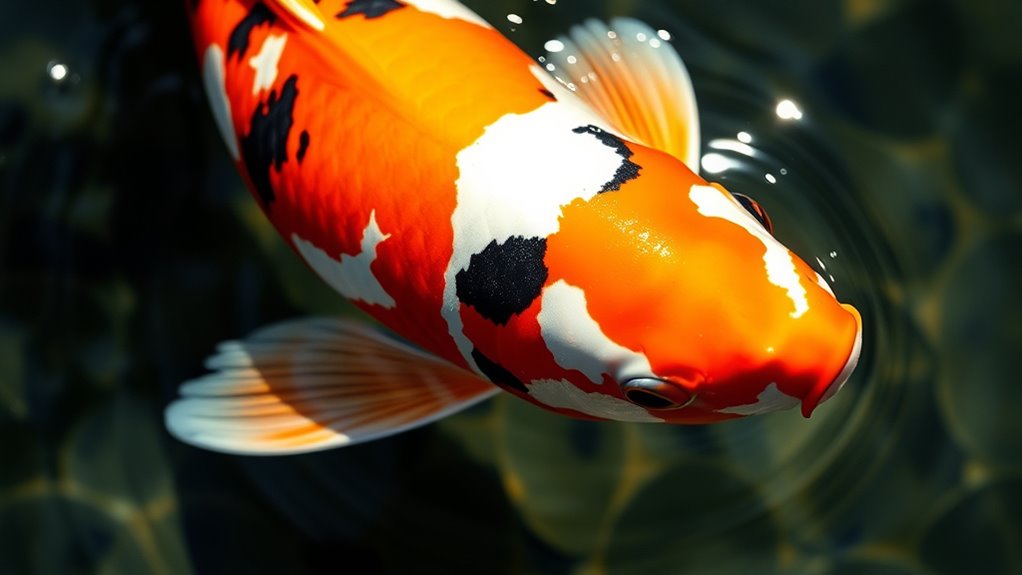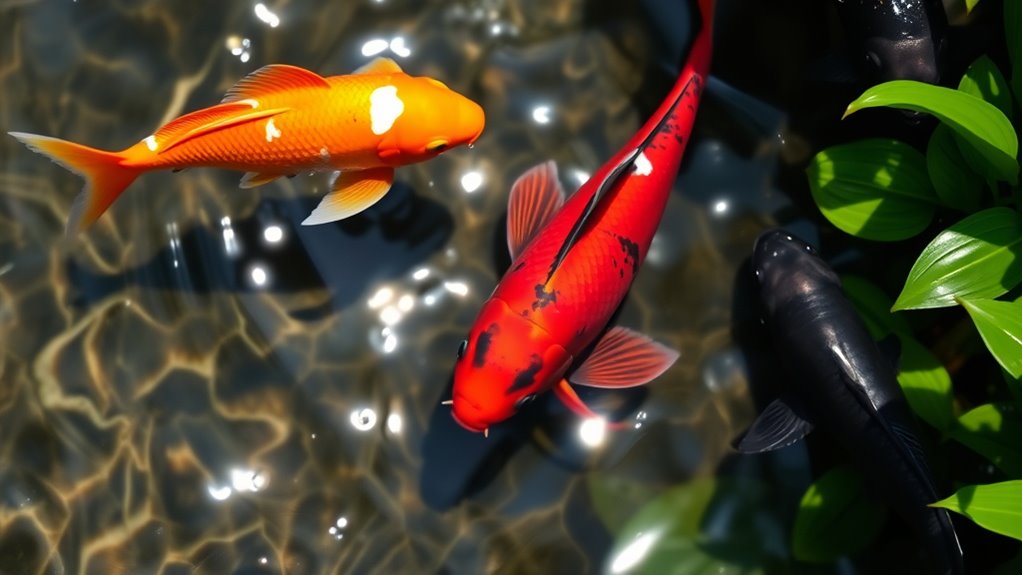Koi fish colors symbolize qualities like purity, strength, and passion that deeply resonate within Asian culture. Red koi often represent love and energy, while white signifies purity and new beginnings. Black koi symbolize overcoming obstacles, and gold signifies wealth and prosperity. Vibrant colors are carefully cultivated through traditional breeding techniques, enhancing both their beauty and symbolic meaning. If you keep exploring, you’ll discover even more about the rich symbolism behind each hue.
Key Takeaways
- Red koi symbolize strength, passion, and intense energy, often representing courage and perseverance.
- White koi stand for purity, innocence, and new beginnings, embodying a sense of peace and spiritual clarity.
- Black koi signify resilience, overcoming obstacles, and strength through adversity.
- Orange koi represent enthusiasm, happiness, and positive energy, reflecting warmth and vitality.
- The specific colors in koi art carry cultural meanings rooted in tradition, emphasizing hope, endurance, and good fortune.

Have you ever wondered what makes koi fish so stunning? It’s not just their vibrant colors, but also the rich symbolism in koi art that elevates their beauty to a deeper level. Koi have been cherished in many cultures, especially in Japan and China, where they symbolize perseverance, strength, and good fortune. Artists often depict koi swimming upstream, embodying resilience and determination, which enhances their symbolic importance. This symbolism in koi art isn’t accidental; it’s rooted in centuries of tradition that celebrate the fish’s ability to overcome obstacles. When you see a koi painting or sculpture, you’re witnessing more than just a colorful fish—you’re looking at a powerful emblem of hope and endurance. The artistry behind these representations often relies on specific color choices to convey different meanings, making the understanding of koi colors even more meaningful. Additionally, the breeding techniques used to cultivate these colors are highly sophisticated, involving selective breeding and environmental control. Behind the stunning display of colors lies sophisticated koi fish breeding techniques. Breeders have developed methods to produce specific hues and patterns, ensuring that each koi carries the desired symbolism and aesthetic appeal. For example, to achieve a bright, pure red or orange, breeders carefully select parent fish with strong color traits and manage their environment to promote vibrant pigmentation. Breeding techniques also involve controlling genetics, water quality, and diet, which all influence the intensity and clarity of the koi’s coloration. This meticulous process not only enhances the koi’s visual appeal but also preserves traditional symbolism associated with each color. For instance, some koi are bred to have a white background with red markings, symbolizing purity and passion, respectively. The techniques ensure that these symbolic colors remain vivid and true to their cultural meanings. Understanding the connection between koi fish breeding techniques and their coloration helps deepen your appreciation for these mesmerizing creatures. Every hue is intentionally cultivated, rooted in centuries of tradition and refined through modern breeding methods. Whether you’re admiring a koi’s shimmering scales or learning about their cultural significance, recognizing the craftsmanship behind their colors adds a layer of respect for both the art and science involved. As you observe koi in a pond or artwork, remember that each color carries a story—one shaped by history, symbolism, and expert breeding. This harmony of tradition and technique is what makes koi fish not only visually stunning but also meaningful symbols that have endured through generations.
Frequently Asked Questions
How Do Koi Fish Colors Influence Their Lifespan?
Your question about how koi fish colors influence their lifespan is interesting. Genetics influence color traits, but environmental factors like water quality, diet, and habitat play a bigger role in their longevity. Brightly colored koi might sometimes need extra care to maintain their health, but their lifespan isn’t solely determined by color. Instead, consistent care and a healthy environment are key to ensuring your koi live long, vibrant lives.
Can Koi Fish Change Color Naturally Over Time?
You might wonder if koi fish can change color naturally over time. Yes, they can, due to factors like genetic mutations and seasonal color shifts. As they age or experience environmental changes, their colors may fade, deepen, or alter slightly. These natural variations are common and part of their growth process. So, don’t be surprised if your koi’s appearance evolves, reflecting their health, age, and seasonal influences.
Are Certain Koi Colors Considered More Valuable for Ponds?
Like a painter’s palette, certain koi colors stand out as more valuable, especially in ponds. You’re drawn to the brilliance of metallic or deep red hues, which often symbolize luck and prosperity. Koi color rarity plays a big role—rare shades like chocolate or lavender fetch higher prices. Ultimately, while personal preference matters, the symbolism and rarity of koi colors influence their value, making some hues more coveted than others.
How Do Koi Color Patterns Affect Their Health?
Your koi’s color pattern genetics can influence their health by affecting their immune responses and stress levels. If the pattern is uneven or complex, it might indicate underlying genetic traits that need careful management. Additionally, environmental color changes, like water quality or lighting, can impact their coloration, potentially stressing the fish and affecting their overall health. Regular monitoring helps maintain vibrant colors and promotes koi well-being.
Do Koi Fish Colors Have Any Impact on Their Breeding Behaviors?
Think of koi colors as a secret language influencing their breeding dance. Your koi’s hue can sway their breeding preferences, making certain colors more attractive partners. Color symbolism plays a role, as some hues are linked to specific traits or qualities, guiding mate selection. So, yes, their colors impact breeding behaviors, acting like a compass guiding their courtship, ensuring the most fitting pairs come together for healthy, vibrant offspring.
Conclusion
Now that you understand what each koi fish color symbolizes, you can truly appreciate their beauty and meaning. Just like a rainbow after a storm, each hue adds its own special touch to life’s vibrant tapestry. Remember, “a picture is worth a thousand words,” and in this case, each color tells a story of hope, strength, and love. Embrace these lessons, and let the colors inspire your journey forward.











